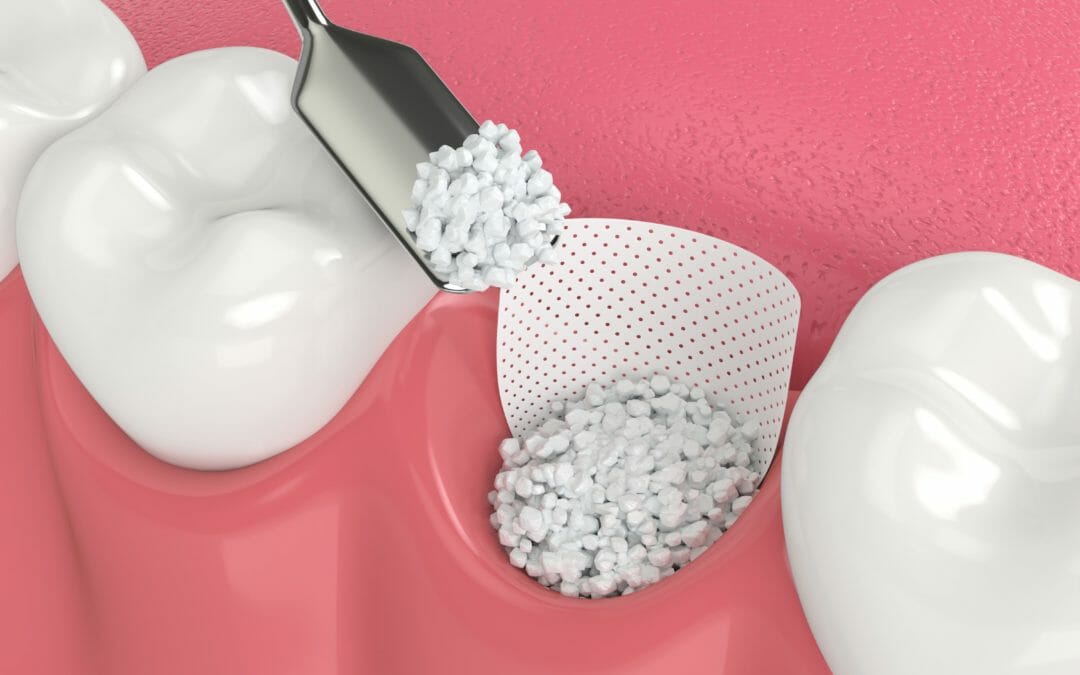Missing teeth can have a severe impact on daily life. From how you eat to how you speak, missing teeth can create many problems. This is where dental implants can come in handy. However, before a dental implant procedure, patients may need bone grafting surgery for successful implant placement. A bone graft is a surgical procedure (Specialist Surgeons routinely perform that) to replace and regenerate jaw bone volume so dental implants can be placed successfully. Bone grafting is taking a piece of bone from another part of your body or using synthetic materials to graft onto your jawbone to provide support and strength. In this blog, we will cover all there is to know about dental implant bone grafting procedures. From understanding what it entails to the step-by-step guide of how it’s done, we’ll also talk about the types of bone grafts used in dentistry and pre-procedure considerations that need to be taken care of. We’ll discuss the recovery journey, risks associated with it, benefits, and factors influencing its success. So, let’s dive into what you need to know about this procedure before proceeding.
Role of Bone Grafts in Dental Implant Surgery
Bone grafts play a crucial role in dental implant surgery. They provide additional support and help create a solid foundation for the implant to integrate with the jawbone. By promoting osseointegration, the fusion of the implant with the surrounding bone, bone grafting increases the success rate of dental implant surgery. Without a bone graft, there may not be enough bone to support the implant, making it an essential procedure in dentistry. In this procedure, equine bone is used as a scaffold to support the additional growth of bone in the sinus, providing the advantages of slower dissolution and microscopic similarity to human bone.
Types of Bone Grafts Used in Dentistry
Socket grafts are used after tooth extraction to preserve the bone socket. Block bone grafts involve taking a small piece of bone from another part of the body and grafting it onto the jawbone. Lateral ridge preservation grafts help maintain the width of the jawbone. Sinus lift procedures involve adding bone to the upper jaw near the sinuses. Different types of bone grafts are used based on the patient’s specific needs.
Socket Grafts
Socket grafts are performed immediately after tooth extraction to preserve bone and promote healing. The graft material stimulates new bone growth and integration with existing bone, preventing bone loss and providing a stable foundation for future dental implants. It contributes to the long-term success of dental implant surgery.
Block Bone Grafts
Block bone grafts are a common type of bone graft used in dentistry. This procedure involves taking a small piece of bone from another part of the body and grafting it onto the jawbone, typically from the back of the jaw. It is often used when there is significant bone loss or defects in the jawbone. The block of bone eventually integrates with the jawbone, providing additional support for dental implants. Expert surgical planning and careful execution are essential for the success of block bone grafts.
Lateral Ridge Preservation Grafts
To maintain the width of the jawbone, lateral ridge preservation grafts are commonly performed during tooth extraction procedures. By placing graft material along the side of the jawbone, this technique promotes new bone growth and prevents bone resorption and collapse of the ridge. It ensures sufficient bone width for future implant placement.
What Happens Before Dental Bone Graft Placement?
Before dental bone graft placement, your dentist will assess your oral health and evaluate the extent of bone loss. X-rays or CT scans may be taken to determine the condition of your jawbone. Any remaining teeth in the affected area may need to be extracted. The treatment plan, including the type of bone graft material and the possibility of dental surgery, will be discussed with you, and antibiotics or other medications may be prescribed to prevent infection and aid in healing.
Post-Surgery Care and Maintenance
Patients should adhere to the prescribed pain management plan after a dental implant bone grafting procedure. They must maintain good oral hygiene through gentle brushing and rinsing with saltwater. It is crucial to avoid strenuous activities and follow any dietary restrictions advised by the dentist. Regular follow-up appointments are essential to monitor healing progress, and any unexpected symptoms or complications should be reported promptly.
Potential Complications and How to Prevent Them
While rare, potential complications of dental implant bone grafting include infection and excessive bleeding. Proper oral hygiene practices and prescribed antibiotics should be followed to prevent disease. Excessive bleeding can be minimized by avoiding strenuous activities and following post-surgery care instructions. Regular follow-up appointments with the dentist are essential to monitor healing progress and address any issues. Following instructions and maintaining good oral hygiene helps minimize complications.
Long-Term Advantages for Oral Health
Dental implant bone grafting offers long-term benefits for oral health. It improves overall mouth health, maintains the natural shape and structure of the jawbone, prevents adjacent tooth deterioration, restores proper chewing function for improved digestion and nutrition, and supports healthy gum tissue around the implant.
Conclusion
In conclusion, the dental implant bone grafting procedure is a crucial step in ensuring the long-term success of dental implants. It allows for the necessary support and stability by enhancing the jawbone structure. Understanding the process, potential risks, and benefits associated with dental implant bone grafting is essential. It is important to consult with a skilled dental surgeon who can perform a comprehensive evaluation and determine the need for a bone graft. Following the procedure, proper post-surgery care and maintenance are necessary for optimal healing and recovery. If you experience any signs of complications, it is essential to contact your dentist promptly. With the right approach and professional guidance, dental implant bone grafting can significantly enhance your oral health and restore your smile.

